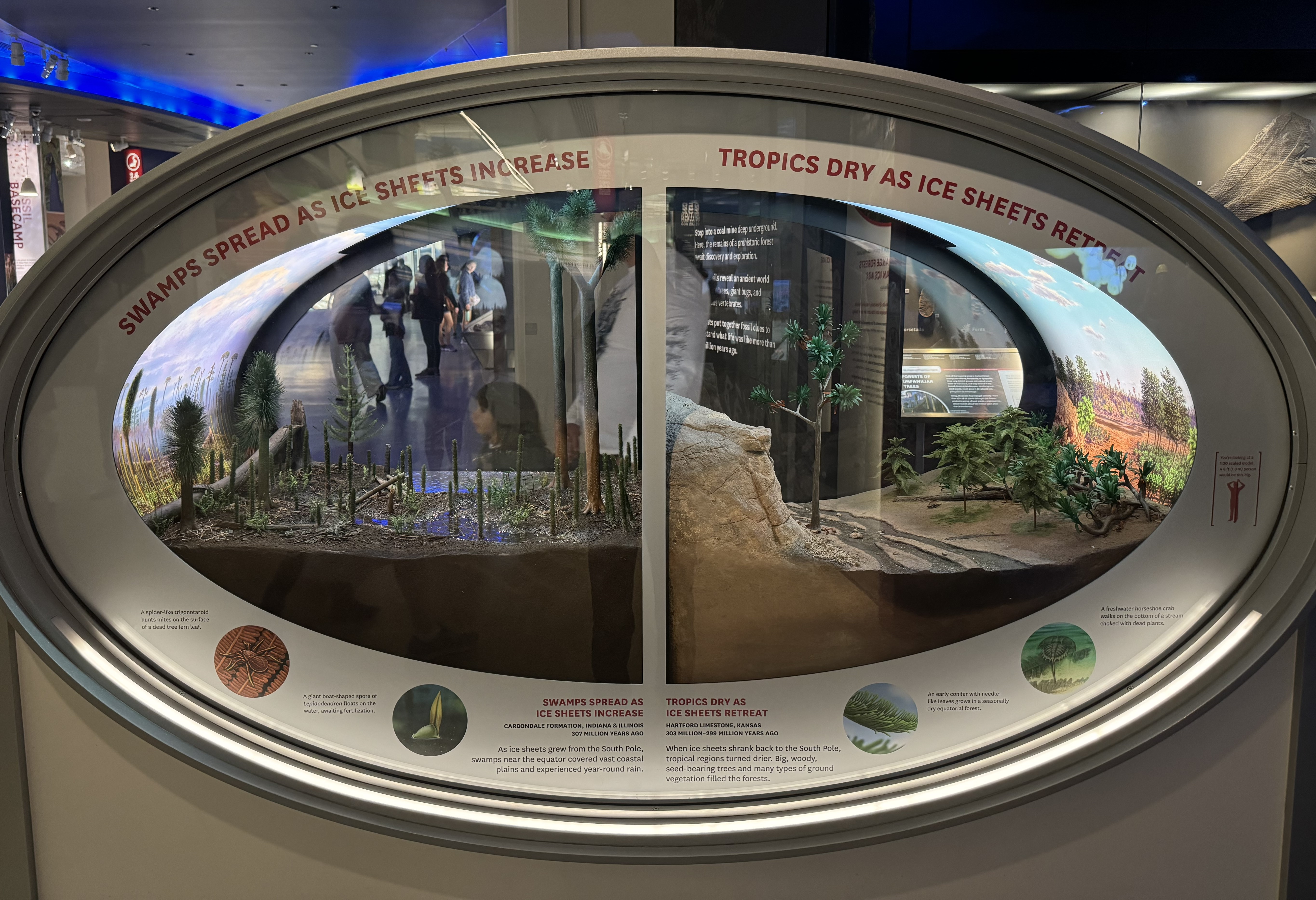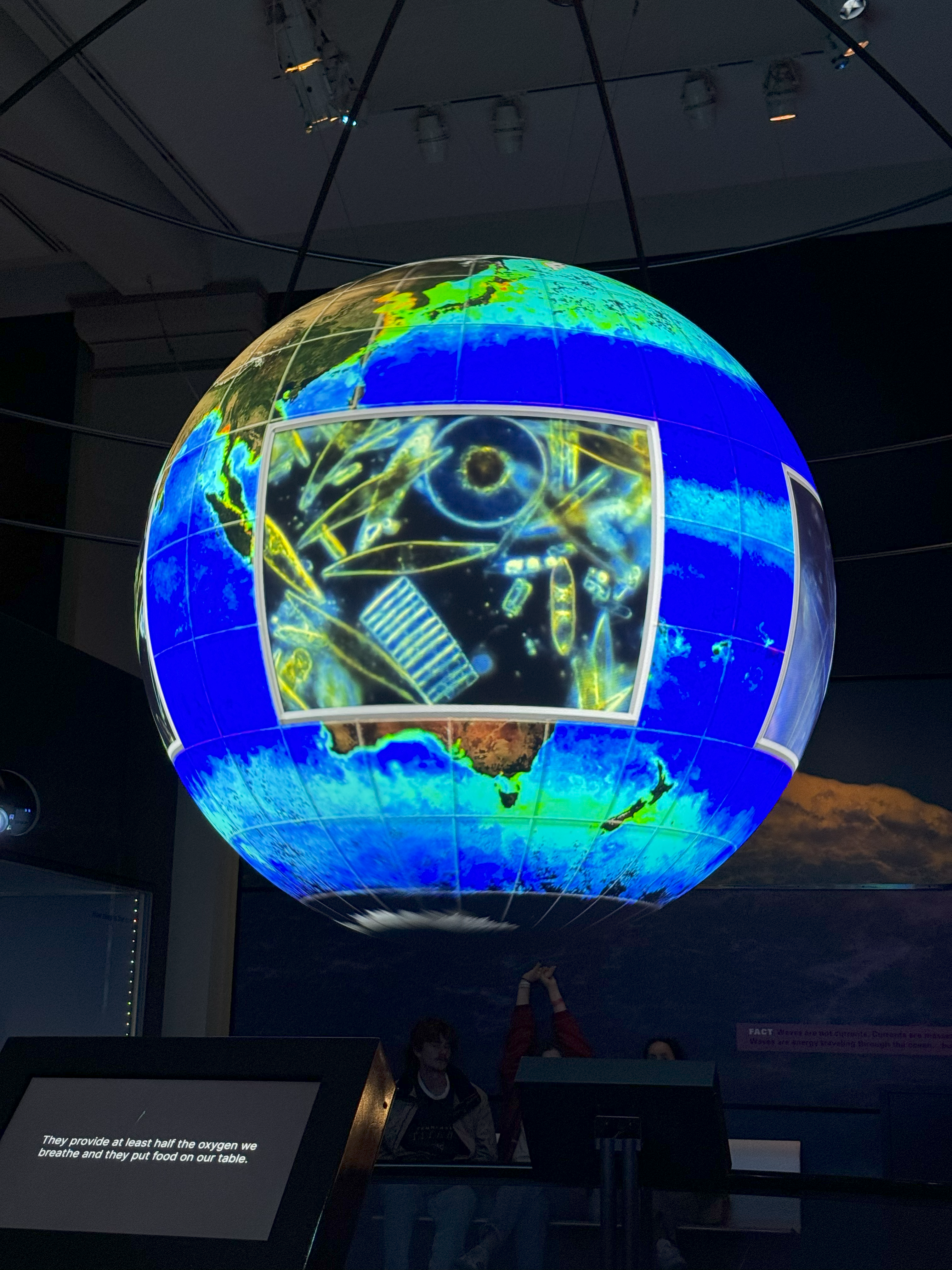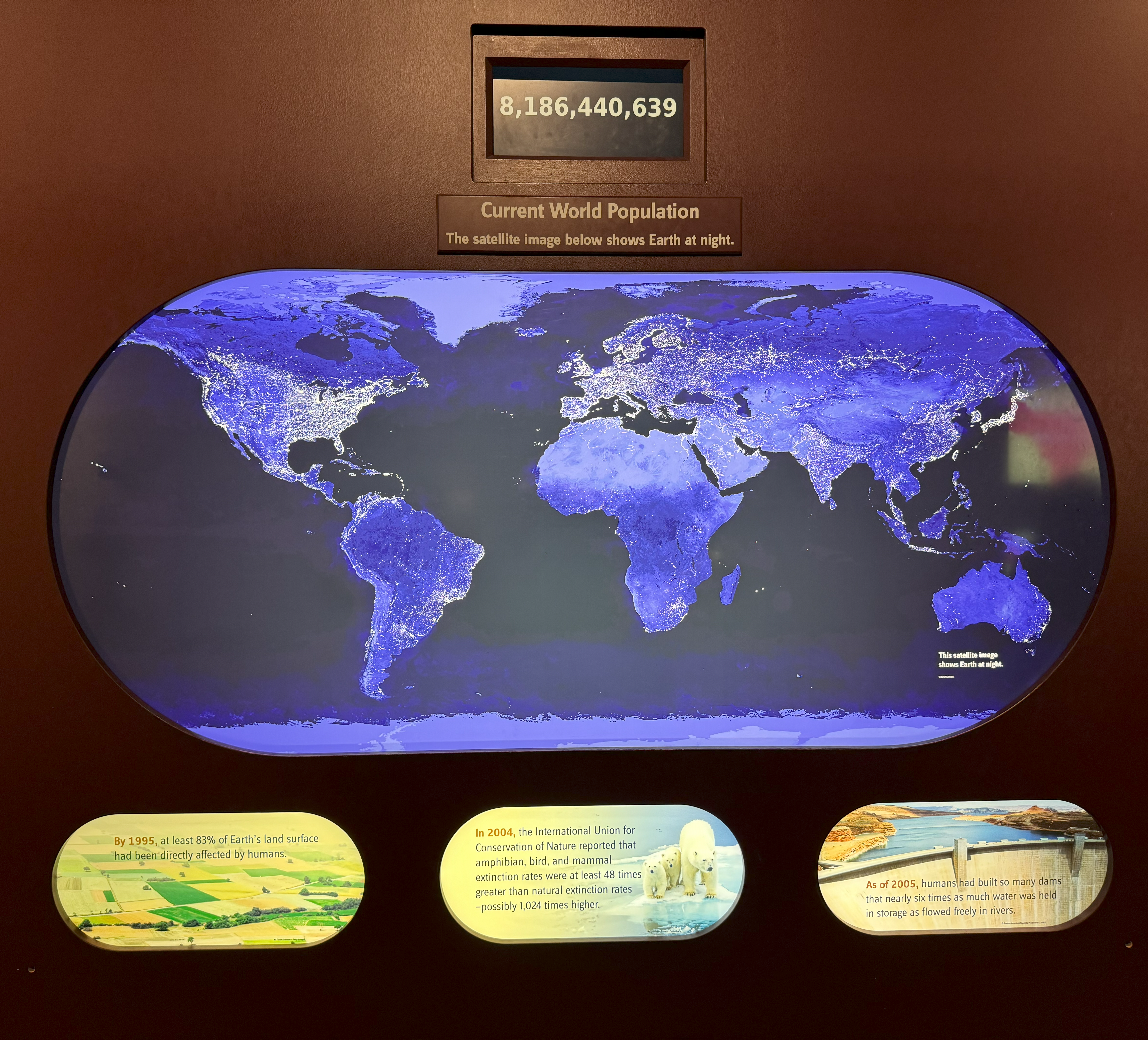National Musuem of Natural History
On October 20, 2024, a group of SGC peers and I gathered in front of the elephant located in the Rotunda of the National Museum of Natural History (NMNH) at 10 a.m. Here, we split up to explore the various exhibits around the museum that highlighted the interconnectivity of the exhibit subject and climate change, paying attention to how these interconnections are portrayed. This discussion of climate change as a consequence of the main subject of the exhibits varied greatly with some exhibits addressing the complexity of the interconnection while others vaguely mentioned the connection. The exhibits I visited included "The Changing Ocean" and "Science on the Sphere" in Sant Ocean Hall, paleoenvironmental dioramas and other exhibits in the David H. Koch Hall of Fossils - Deep Time, "Humans Change the World" in David H. Koch Hall of Human Origins, and the temporary exhibit, "Cellphones: Unseen Connection".
Sant Ocean Hall
I began my exploration in the Sant Ocean Hall at the "Science on the Sphere" exhibit, which projected continuous videos of Earth’s natural processes onto a globe. There I watched two segments: “An Ocean of Change” and “Ocean Motion”.
“An Ocean of Change” discussed how tectonic plates reshape land formations on Earth for the last thousands and years, and continue to change thus causing natural disasters like volcanic eruptions, earthquakes, and tsunamis.“Ocean Motion” explained how ocean currents impact weather patterns, guide travel, and transport nutrients by breaking down the currents into three levels.
Both segments dynamically displayed the subjects being discussed on the globe that represents the Earth. The shifts in tectonic plates over thousands of years and the seemingly invisible patterns of ocean current movements that control nutrient and heat flow are all shown to the viewer of the segments. Visitors of the museum can easily visualize the changes and movements described in the videos. By combining narration, text of the transcript on surrounding displays, and visualizations, "Science on the Sphere" effectively catered to the different learning styles, making the content more comprehensible to the general public.
From there I headed towards the front right wall of the hall where "The Changing Ocean" is located. The exhibit has two interactive video stations exploring interaction of oceanic and human activity.
The first video I watched was the "Great Pacific Garbage Patch" which explained that there exists many garbage patches, collections of concentrated waste composed of mainly microplastics that form from the rotation of ocean currents. Even though its main composition is microplastics, the garbage patches can reach the surface of the sea from the sea floor, making it impossible to clean up without disturbing marine life. The only viable solution to the problem presented by the video is prevention of the debris that forms the mass by recycling, reusing, and reducing our usage. The video broke down terminologies and addressed the misconception that garbage patches are large thus easy to remove while showing visuals of the current movements that carry debris to form the mass, and the scope of the issue for the general visitor of the museum.
"No Sunlight No Problem", the second video, explores the role of chemosynthetic microbes in the deep ocean ecosystems and their interaction with methane seeps that form when organisms decompose and help maintain fish populations. Using the energy generated from consuming methane, thus sequestering the greenhouse gas, chemosynthetic microbes create habitats of rocks for fish to live and hide in while maintaining methane seeps that allow diverse ecosystems to thrive and manage fisheries. Compared to the previous video, this video is far more complex due to its specialized subject matter. The video features more technical terminology that is not accompanied by narration, but rather text explanation of the term, requiring the viewer to process different auditory and text information simultaneously. This change in format makes it more difficult to understand the information presented in the video. Extending the length of the video to allow for extra narration or explanations of the process can help the general visitor understand the complexity of chemosynthetic microbes and methane seeps better.
David H. Koch Hall of Fossils - Deep Time
Next, I explored David H. Koch Hall of Fossils - Deep Time to understand how climate and environments have changed through the scaled model reconstructions of the past habitats in dioramas.
The “Lush Rainforests” diorama is set in Willwood Formation in Wyoming 56 to 53 million years ago which depicts dense forests that thrived from the warm, humid temperatures after the extinction of dinosaurs. Atmospheric carbon dioxide level was five times higher than they are today with the average global temperature being 14-25 degrees Fahrenheit higher. Due to the high global temperature where glaciers are unable to form, the global sea level was about 650 to 720 feet higher than today with much of the current land being underwater.
Another diorama, “Swamps Spread as Ice Sheets Increase” and “Tropics Dry as Ice Sheets Retreat” set in Carbondale Formation in Indiana and Illinois 307 million years ago and Hartford Limestone in Kansas 303 to 299 million years ago, depicts the change in North America’s environments from the changes of ice sheets in the South Pole. Back then, the atmospheric carbon dioxide level was similar to that of today yet the average global temperature was 6 degrees Fahrenheit lower to 4 degrees Fahrenheit higher than today. This is due to the formation and retreat of ice sheets in the South Pole. When temperatures dropped, sea levels decreased due to the ice sheet formation, forming swamps on coastlines near the equator while trophic areas thrived as the temperature rose and sea level rose. The global sea level at the time was up to 130 feet higher than that of today.
While I think the dioramas provide an in-depth visualization of the changes in the environments through the millions of years of Earth’s history and correspond to the data discovered about the time period, I feel like they could’ve been better at presenting how drastic the difference between then and now is. Including an image of the current environment in contrast to the past environment. By including a reference for exactly how big of a difference the change in atmospheric carbon dioxide level, average global temperature, and rise level actually is can really emphasize the importance of the necessity to protect our Earth and mitigate climate change’s effect. Otherwise, the dioramas and the accompanying information about the climate being presented is essential to understand how changes to the climate influence our environments.


Moving towards the exhibit along the low wall and benches, I began to explore one of the most climate change centric exhibits in the museum, featuring the past and present of climate change. “Bridges Allowed Migration” described the changes in climate since 2.6 million years ago. These climate change events altered migration paths as explained in “Bridges Allowed Migration” where the formation and receding of ice sheets, land bridges, split the population of organisms between Eurasia and the Americas and caused others to go extinct due to their inability to adapt to the new environment, this included ancestors of humans. Archaeological artifacts and skeletons are used to estimate the movement of animals and humans and further DNA analysis of ancient bones and current organisms can help determine when the split occurred.
There also featured a section, “Humans Continue to Change the World”, that describes the human impact on species extinction over the last 70,000 years, the most direct callout of the detriment of humans on the environment through our contribution to exacerbating climate change. Here I learned that we’ve significantly altered at least 75% of Earth’s land, and as our footprint grows, the more stress we place on other species’ resources which drives them closer and closer to extinction. This is gathered from the difference in extinction rates and causes that are more sporadic than the extinction driven solely by climate change of the past as organisms of all traits can and are at risk of extinction.
This exhibit does an excellent job at presenting the extent of human impact on climate change and respectively on global environments. The comparison between past and present climate change patterns and their effect on biodiversity especially emphasizes the role of humans in the severity of climate change now compared to the past.
David H. Koch Hall of Human Origins
Before leaving the first floor I headed to the David H. Koch Hall of Human Origins to learn more about human evolutionary history and our impact on the world. There the evolutionary history of humans was heavily discussed, from the change in our foot shape and skeletal structure for improved support, the creation of new tools for hunting, to the evolutionary difference between us due to our environmental difference.
In the small exhibit “Anthropocene Event” hidden at the end of the Hall, human impact on Earth’s land, animal extinction, and water is finally addressed after only previously briefly showing graphs of past climate change and current carbon dioxide level changes. This information is displayed in three small panels underneath the much larger global display of the growing count of our population. It is stated that more than 83% of the Earth’s land surface has been affected by human activity for agriculture, housing, and other infrastructure. Human activity has also increased the extinction rates of amphibians, birds, and mammals by 48 to 1,024 times more than than the natural extinction rate. Our infrastructure, specifically dams, stores six times more water than what is free flowing in rivers.
After thoroughly examining the hall, I would have to agree with critics that the human impact on the environment and climate change is de-emphasizes through how they chose to communicate the data on our influence. The information is very limited with little effort in expanding the statistics presented and how they are factors of climate change that are harmful to the environment on Earth. Instead, the exhibit presents the same graphs and explanations of past climate change and current carbon dioxide level changes twice as does little to explicitly state the harm we inflict on the Earth and when it does it's overshadowed by the information on the prowess of human development.
Cellphones: Unseen Connection
Finally, on the second floor I reached the final exhibit of the day, “Cellphones: Unseen Connection.” The exhibit is centered around the origins, history, and impact of cellphones by using three main presentation techniques: interactive devices, display cases, and comics.
The interactive devices are in the form of screen displays similar to those found across the museum but the most noticeable implementation are the giant screens that greet you at the doors of the exhibit, prompting you to pose for a full body selfie, placing filters on your face, and asking you to join a group chat. While eye-catching, this grand display wasn’t very effective at explaining about the topics of the exhibit in comparison to the traditional screen displays as they didn’t have a specific purpose. The display cases were both displays and interactive pieces that allowed you to physically observe the topic at hand like the elements needed to create a cellphone and the number of phones we collect over our lifetime all being shoved in nightstand drawers. This median of messaging was much more effective as it conveyed a specific message of the excess and waste of phone production for their short lifespan while still being able to keep the museum visitor actively engaged with the exhibit. The comics at the end of the exhibit were also a good way of messaging as it combined short content that most people find palatable with the impacts of cell phones and social media.
Waste is heavily emphasized in the exhibit as most raw material acquired in the production of cell phones end up in waste as it is difficult to recycle such material and can only be reused for a certain amount of time. As stated above, the stockpiling of devices in drawers even though we no longer have use for the old devices prevents materials from being recovered for reuse with a whole section of the exhibit being dedicated to the cellular carbon footprint. Intentionally wasteful cellphone design also heavily contributes to this footprint. The exhibit holds a strong stance against e-waste as it is detrimental to the environment as it only increases landfills that release carbon into the atmosphere.
In addition, the exhibit explored the technological and social impacts of cellphones. One such technological development is the expansion of infrastructure developed to support cell phone usage including fiber optic cables, wired, computer equipment, and data centers, that allows the near speed of light signal that we now have. The mock cell tower is only a small part of the complex system we created. The social impact of cell phones is expansive. Increased participation and awareness of social justice movements is facilitated by cell phones with the exhibit highlighting the Arab Spring in a comic, in which the civil rights movement was organized through social media. This instant communication with others is essential to our existence now.























